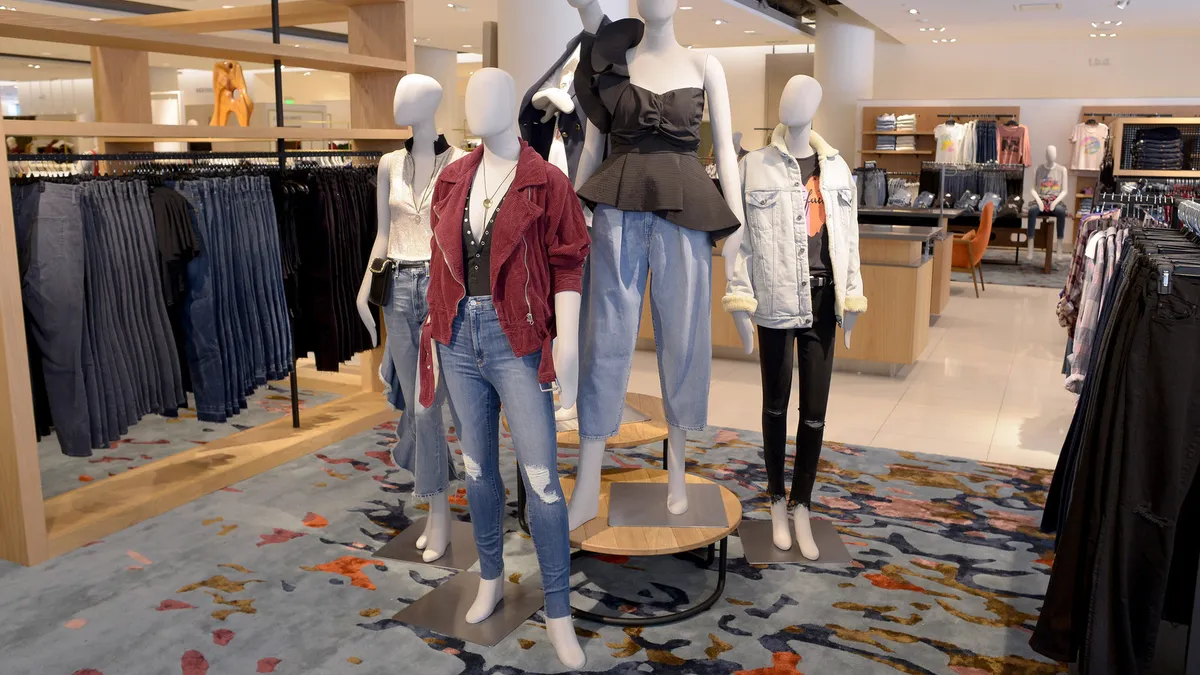Dive Brief:
-
Nordstrom is featuring extended sizes at its new Century City store opening in Los Angeles on Tuesday, the company said in a press release. While most women's contemporary brands start with size 2 or 4 and go up to size 12, with plus sizes ranging from 18 to 24, Nordstrom is asking its customers' favorite brands to add in more zeros, 2's, 14's, 16's and 18's.
-
Denim brands were the first to be approached, and mannequins on display will reflect the more inclusive sizing as well, according to the release. Rather than relegating the sizes to their own petite or plus departments, all denim sizes will be featured together, side by side in one department, the company said. The department store will continue with its specialized petite and plus sections, however.
-
To start, participating brands include Topshop, Rag & Bone and Madewell, as well as Nordstrom private label brands Caslon and Halogen. For the holidays, some 40 brands have committed to offering extended sizes on Nordstrom.com, including in swimwear, activewear and ready-to-wear. For spring, the initiative will grow to 60 brands and inclusive sizing will be available in 15 stores.
Dive Insight:
The ongoing discussion around specialized sizes, particularly in plus-sized fashion, includes a push not just for more options but also for inclusive sales. The inclusive market, by definition, covers a larger segment of the population: Two-thirds of U.S. females consider themselves to be a special size, meaning, plus, petite, junior or tall, according to market research company NPD Group’s Consumer Tracking Service. One-third of females identify as plus-size, the same study notes.
Special sizes in the U.S. are changing with its demographics. U.S. teens shopping in the junior size category dropped from 81% in 2012 to 73% in 2015, while teens purchasing plus-size clothing is now 34%, compared to 19% in 2012, NPD found. In the overall women’s category, NPD found that in 2015, the plus-size market accounted for 17% of the U.S. women’s apparel market overall. Furthermore, U.S. sales of women’s plus-size apparel, which includes plus-size/full-figure, petite plus and junior plus sizes, increased 5% in the 12 months ending February 2015 to $19.8 billion, and 3% in the 12 months ending February 2016 to $20.4 billion.
That's a significant market, and the current sales methods, which force shoppers to head to specialized departments or retailers, (in some cases only to be found online), are increasingly alienating those customers. At a time when "disruption" is the name of the retail game, plus-size retail in particular and inclusive sizing in general are ripe and ready to be disrupted. The area not only suffers from marketing and merchandising neglect, but also has potential customers clamoring to buy. Canadian plus-size clothing chain, Addition Elle, is just one retailer who recognizes those challenges and sees potential in the U.S. market.
Nordstrom is the latest retailer to get more assertive in the space. Online plus-size fashion brand Eloquii, originally founded by The Limited in 2011, is a hit with shoppers, and earlier this year opened its first brick-and-mortar store in Columbus, OH. J.C. Penney has also seized on the opportunity: CEO Marvin Ellison has said that an emphasis on plus sizes will be part of its turnaround strategy. Penney also tapped fashion designer and "Project Runway" winner Ashley Nell Tipton for a designer collection in its Boutique+ plus-size private label last year.
Upstart brands like ModCloth (now owned by Walmart) have consistently catered to women of all sizes, though luxury retail is still largely absent in the space, Toni Box, senior director of social media and content at PMX Agency, told Retail Dive last year.
In her statement Monday, Nordstrom executive vice president and general merchandise manager for designer, women's and kids apparel Tricia Smith put her finger on the issue, saying, "They're just sizes."
"Our customers have been asking for a broader range of sizes on both sides of the spectrum – the zeros and 2's and beyond size 12," she said. "We recognize the opportunity to serve customers better by having more sizes. Style and fashion apply to everyone. They're not created for a limited group of sizes. We don't view being size inclusive any differently that the need to be more inclusive across the board — whether it's ethnicity, size or body type. In our opinion, petite and plus sizes shouldn't be considered special categories."













